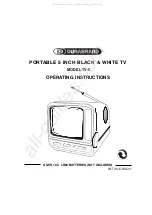
16
6-2. Installation Procedures
WARNING : SUFFOCATION FROM EXHAUST FUME
Do not operate the generator in poorly ventilated areas such as indoors or
tunnels, as the exhaust gas of the engine contains substances that are
harmful to human health.
Do not direct exhaust fumes at pedestrians or buildings.
CAUTION : FIRE
Do not bring flammable items (such as fuel, gas and paint) or items that are
highly combustible near the generator as the muffler, exhaust gas and other
parts become extremely hot.
Keep this generator 1m or more from walls or other hindrances, and on a
level surface.
Remove the wood ties if using anchors to secure the generator
Do not connect the generator output to indoor wiring.
If installing this generator, set up barriers or fencing completely around the boundary
line of the construction area and take measures to prevent persons not involved in the
construction from entering the area.
Always set the generator on a hard, flat and leveled surface that serves as the
foundation.
Keep the generator 1 m or more from walls or other hindrances so that the operation
panel door and left/right check doors are accessible for internal inspection/maintenance.
< Note >
This equipment must be operated on hard and flat surface. Operating under any other
conditions may result in malfunctions.
Do not block the airflow from radiator vent or muffler exhaust. It may result in reduced
engine performance, overheating, or damage to the electrical parts.
Operating in dusty area or salty air (by the ocean), or any other particulate environment
may result in clogged radiator, which may cause overheating, other malfunctions and insulation
deterioration. Use extreme care, frequent checks and maintenance.
7. Load Connections
7-1. Load Cable Selection
CAUTION : PROPERTY DAMAGE
Cable burnout can occur due to generated heat if the load current exceeds
the allowable current of the cable.
The voltage drop between cables is large if the cable is excessively long or
thin, resulting in decreased input voltage to equipment using the generator,
thereby causing decreased performance, faulty operation and malfunction.
Select cable for use that has sufficient thickness and an allowable current possible for use,
giving consideration to the distance from the generator to the equipment using the
generator.
< Note >
Select cable with a thickness that ensures that the voltage drop across the cable will be within 5%
of the rated voltage.
Summary of Contents for DG20MK-P
Page 2: ......
Page 43: ...40 13 Generator Circuit Diagram...
Page 44: ...41 14 Engine Electrical Circuit Diagram...
Page 45: ...42...
Page 46: ...43...
Page 47: ...44...
Page 48: ...2016...
















































